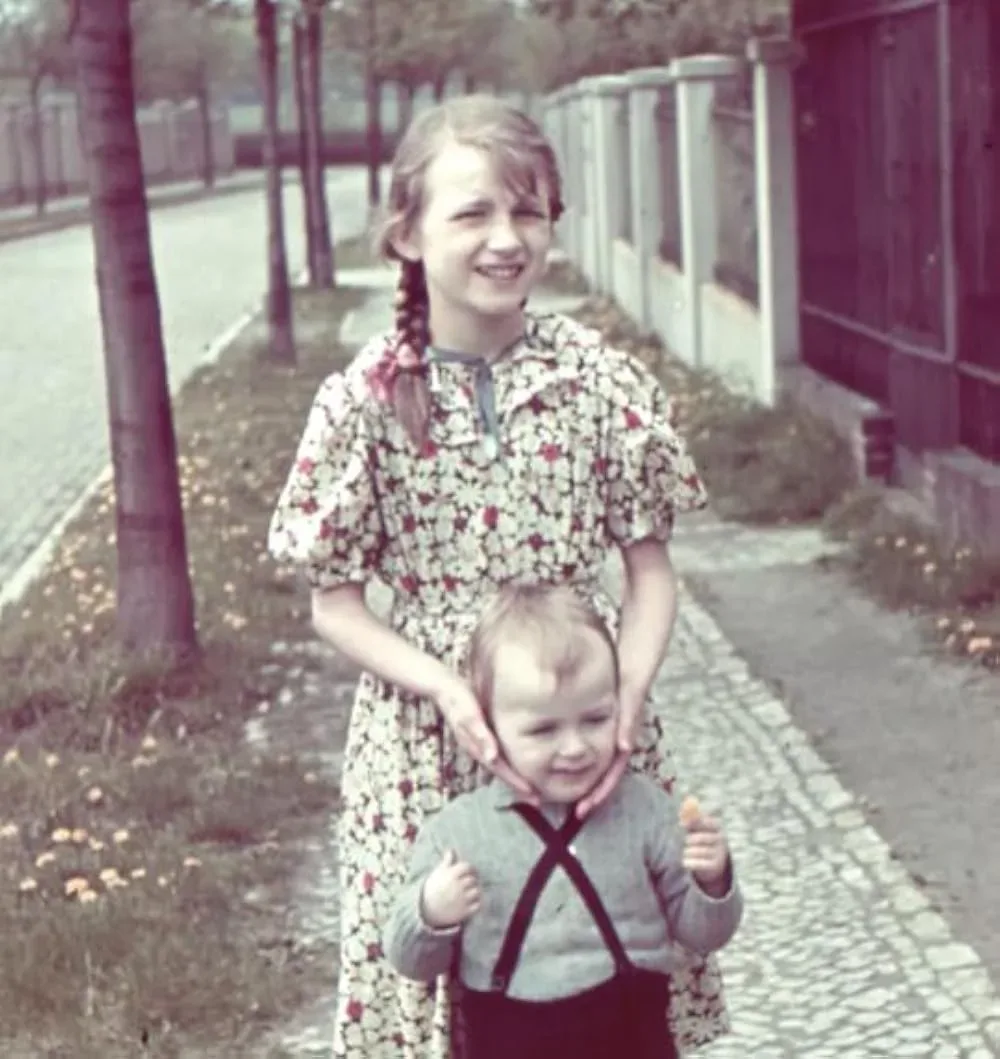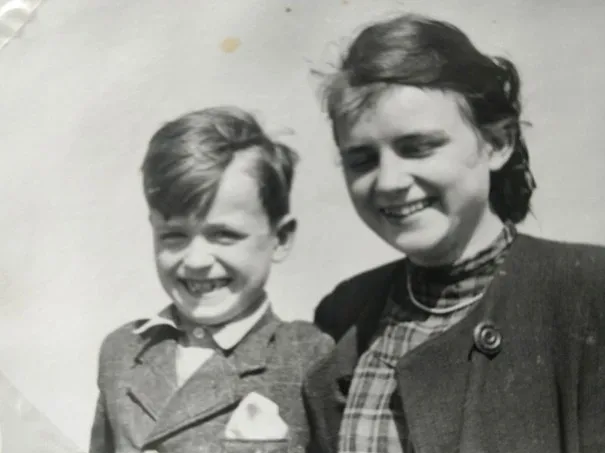They were evacuated by the White Buses, but one question remains: did Folke’s sister Vera really want to be evacuated?
As the years go by, the siblings will make very different choices in life.
“The white Volvo bus chugs through the flat landscape, powered by wood gas. Inside are about thirty Swedish-born mothers with their children. The women are married to men who are unable to leave the country. Three of the passengers are Vera, her mother, and her little brother.
One final border check. The bus moves on under the sharp spring sun. Vera is crying, and a few others hesitantly begin to sing the German national anthem. It feels a little like betrayal—to leave the country to its fate.
Then, almost imperceptibly, the bus rolls across the border. Soon, a shop appears with a sign where the letter “o” is crossed out, and the flags no longer bear swastikas on red backgrounds, but white crosses.
The bus leaves behind the war, the Führer, the advancing Russians, the ruins, the bombed-out nights, a shrinking country, husbands and friends. It’s as if a selected group of privileged people are fleeing in a spaceship from a doomed planet. They are being saved because of their Swedish connection.”
That’s how Folke begins his book, Vera’s Journey – My Sister the National Socialist, about his sister Vera Oredsson, born Schimanski.
Header: Folke and Vera. Private collection.
The Childhood
Vera was born on February 21, 1928, and Folke on May 18, 1936, in Berlin. Their parents were Greta Svensson, who was born in Sweden, and the German Hans Schimanski.
Greta came from a Swedish family that moved to Berlin when her father studied to become an architect. Hans was a trained engineer, and the couple met while living in neighboring apartments in a Berlin apartment building.
Folke describes his mother as artistic, disorganized, and hot-tempered, while his father was methodical, orderly, and controlled. Their differences made the marriage an unhappy one.
As a child, Folke was beaten by his father—but not nearly as much as his older sister, Vera. Their father hit Vera for her poor grades, especially in math, and because she was seen at school as too lively and mischievous.
Folke describes himself as the little brother who received all the positive attention from their parents—something that often made Vera tease and pinch him, which over time turned into mockery and scorn.

While the family was living in Germany, Greta was a homemaker while Hans worked as a civil engineer.
The family’s finances took a serious downturn when Hans lost his job in late 1931, as a result of the economic crisis that hit Germany during the interwar period. The same year Hitler came to power, their father joined the SA (Sturmabteilung). According to Folke, he was given an SA uniform, a dagger, and a trumpet. Hans’s role in the SA is described as more of a follower than an active participant—but he was a staunch antisemite and a committed Nazi.
At the time, the family lived on Markelstrasse in the district of Steglitz, in southwest Berlin—one of the city’s most Nazi-friendly areas. In the July 1932 election, 42 percent of Steglitz residents voted for Hitler’s party, the NSDAP, compared to an average of 28 percent across Berlin.
Folke describes his sister as a mischievous tomboy who came into contact with and sympathized with Nazism at an early age. At school, she was seen as strange and unbearable, uninterested in her studies, and disruptive in class.
Unlike Vera, Folke was described by their parents as a “good little boy.”
Vera escaped her father’s scolding and beatings when she was sent to a KLV camp (Kinderlandverschickung), a German version of what in Sweden were known as children’s summer colonies. There, children were indoctrinated in Nazi ideology, and Vera came under its influence early on.
She first joined the JM (Jungmädel) and later the BDM (Bund Deutscher Mädel), where she found a sense of belonging and purpose in Nazism.
Krigsslutet och flykten till Sverige
Later, their father got a job at Siemens and was relocated during the war to Sachsen, near the border with Czechoslovakia.
He was never drafted into military service, as his engineering skills were considered valuable for industry and production.
Greta and the children remained in Berlin but were evacuated eastward during the Allied bombings. As the war drew to a close, they were forced to flee from the advancing Red Army and eventually returned to a bombed-out Berlin.
There, they received food parcels from the Swedish Victoria Congregation. At first, they stayed in their old apartment, but when living conditions became too harsh, they moved into the congregation’s building, where they lived alongside other Swedish-German women and their children.
Long after the war, Folke learned that the congregation had secretly hidden Jewish refugees in the attic—something that had been kept from most people.
It was outside this very building that the family first encountered the White Buses. Thanks to Greta’s Swedish background, they were eligible to be rescued as part of the Red Cross operation. Their father, who was still in Saxony, was not included in this quota.
The first journey went from Berlin to Lübeck—a trip Folke described as uncertain and tense. He remembered how the bus driver kept a constant eye on the sky, since British RAF planes sometimes attacked Red Cross vehicles, not always realizing they were painted white with red crosses and Swedish flags.
Upon arrival in Lübeck, they were given cabbage soup, and Vera recalled:
The first night was spent on straw mattresses on the floor, but the next day we were given wooden bunk beds. There were 28 of us in a room of about 24 square meters. After a while, the children came down with either the flu or whooping cough, and I got pneumonia on my 17th birthday. And we had lice—those days I remember as a nightmare.
Before the family could leave Germany, they had to be deloused. Their clothes were treated with gas, and Vera noticed a sign above the door that read “Gas chamber”, where the clothes were disinfected. Later in Sweden, she wondered if this had been confused with reports about the Nazis’ genocide.
During her time in Lübeck, Vera tried for a long time to wear her brown BDM jacket with the swastika armband, but a Swedish Red Cross soldier forbade her. Her mother Greta secretly traded the jacket for some eggs to avoid trouble—something Vera never forgot.

Shortly after Easter 1945, the family continued their journey through Denmark. In Odense, they were welcomed with singing and a festive meal before traveling on to Sweden. For Vera, this was a painful experience. She felt she was betraying “the Reich” and later spoke about it with tears in her voice during a radio program: “It hurt,” and “I wondered what I was getting myself into.” She was referring to her decision to travel with the White Buses to Sweden.
The final leg was by ferry across the Öresund Strait. On April 6, 1945—several weeks before the first group of Jewish survivors arrived in Sweden—Vera, Folke, and Greta disembarked in Malmö.
Life in Sweden
Folke studied history, economic history, political science, economics, and theoretical philosophy at the universities of Lund and Stockholm.
He went on to work as a journalist and author, and held several other positions, including at the Swedish Parliament’s Research Service, SIDA, the UN aid office in Tehran, and Swedish Radio.
Unlike his sister Vera—who became one of Sweden’s most well-known and active Nazi politicians—Folke took a clear and strong stand against National Socialism.
